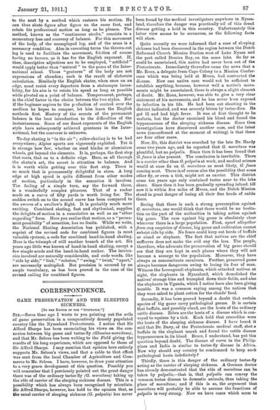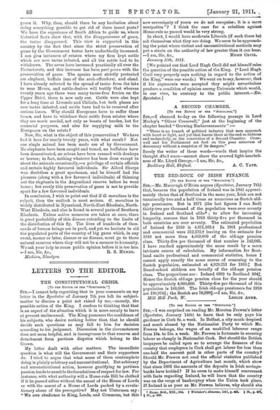CORRESPONDENCE.
GAME PRESERVATION AND THE SLEEPING SICKNESS.
[To THE EDITOR OF THE " SrEcTATOR.1 Six,—Some time ago I wrote to you pointing out the evils of game preservation in a comparatively densely populated country like the Nyasaland Protectorate. I notice that Sir Alfred Sharpe has been enunciating his views on the con- nexion between big game and tsetse-fly (Glossina morsitans), and that Mr. Selous has been writing to the Field giving the results of his long experience, which are opposed to those of Sir Alfred Sharpe. I may mention that opinion here entirely supports Mr. Selous's views, and that a cable to that effect was sent from the local Chamber of Agriculture and Com- merce to Mr. Selous. I have, however, to draw your attention to a very grave development of this question. Possibly you will remember that I previously pointed out the great danger there was of the ordinary tsetse-fly (G. morsitans) taking up the role of carrier of the sleeping sickness disease. This is a possibility which has always been recognised by scientists. Sir Alfred Sharpe, however, has held to the opinion that, as the usual carrier of sleeping sickness (G. palpalis) has never
been found by the medical investigators anywhere in Nyasa- land, therefore the danger was practically nil of this dread disease getting a bold in this country. Unfortunately this latter view seems to be erroneous, as the following facts will show.
Quite recently we were informed that a case of sleeping sickness had been discovered in the region between the Dutch Reformed Church Mission Station west of Lake Nyasa and the port called Domira Bay, on the same lake. So far as could be ascertained, this native had never been out of the Protectorate. Immediately thereafter came the news that a Mr. Roux, a delegate from Cape Colony to a Mission Confer- ence which was being held at Mvera, had contracted the disease. Now one native case would not be sufficient to establish anything, because, however well a native's move- ments might be ascertained, there is always a slight element of doubt. Mr. Roux, however, was able to give a very clear statement of his movements, and he has never 13;n exposed to infection in his life. He had been out shooting in the district indicated, and was severely bitten by tsetse-flies. He got ill and had high fever. It was at first thought to be malaria, but the doctor examined his blood and found the trypanosomes of the sleeping sickness disease. Since then investigations have discovered another case, and the latest news (unconfirmed at the moment of writing) is that there are four other cases.
Now, Sir, this district was searched by the late Dr. Hardy some two years ago, and he reported that G. morsitans was plentiful, but no palpalis. Since then it has been found that G. fusca is also present. The conclusion is inevitable. There is a carrier other than G. palpalis at work, and medical science would at once fix on G. morsitans as most likely, G. fuses coming next. There is of course also the possibility that some other fly, or even a tick, might act as carrier. This district some ten years ago only contained tsetse near to the lake shore. Since then it has been gradually spreading inland, till now it is within five miles of Mvera, and the Dutch Mission stand in great danger of losing all their fine herds of cattle there.
Seeing that there is such a strong presumption against G. morsitans, one would think that there would be no hesita- tion on the part of the authorities in taking action against big game. The case against big game is absolutely clear wherever there is a large population. First, apart altogether from any suspicion of disease, big game and cultivation cannot subsist side by side. No fence could keep out herds of buffalo or eland or elephant. The fact that natives are the chief sufferers does not make the evil any the less. The people, therefore, who advocate the preservation of big game should see that they are kept in such places where they will not become a scourge to the population. Moreover, they have always as concomitants carnivora. Further, preserved game always becomes dangerous owing to losing its fear of man. Witness the Lomagundi elephants, which attacked natives at sight, the elephants in Nyasaland, which demolished the natives' storage bins and trampled down their fields, and also the elephants in Uganda, which I notice have also been giving trouble. It was a common saying among the natives that they were asked to plant cotton for the elands' food.
Secondly, it has been proved beyond a doubt that certain species of big game carry pathological germs. It is certain that buffalo, and possibly eland, are the hosts of the ordinary cattle disease. Zebra are the hosts of a disease which is con- veyed to equines by a tick. Koch held that crocodiles were the hosts of the sleeping sickness disease. I have heard it said that Dr. Davy, of the Protectorate medical staff, shot a buffalo in the elephant marsh and found the cattle disease trypanosomes in its blood. Bruce, I understand, has put this question beyond doubt. The disease of surra in the Philip- pines and India is similar to tsetse-fly disease in Africa. Now why should any country be condemned to keep such pathological hosts indefinitely?
Thirdly, there is this danger of the ordinary tsetse-fly acting as the carrier of sleeping sickness. A German doctor has already demonstrated that the role of manila= can be taken by palpalis,—that is, that palpalis can convey the common tsetse disease to domestic animals, thus taking the place of morsitans; and if this is so, the argument that morsitans will probably be able to assume the functions of palpalis is very strong. Now we have cases which seem to prove it. Why, then, should there be any hesitation about doing everything possible to get rid of these insect pests? We have the experience of South Africa to guide us, where historical facts show that, with the disappearance of game, the tsetse disappeared. This view is supported in this country by the fact that since the strict preservation of game by the Government tsetse have undoubtedly increased. I can giva instances of estates where my firm kept cattle which are now tsetse infested, and all the cattle had to be withdrawn. The areas have increased practically all over the Protectorate, and this increase has been paripassu with the preservation of game. The species most strictly protected are elephant, buffalo (one of the arch-offenders), and eland. I have already referred to the spread of tsetse from the lake to near Mvera, and cattle-dealers will testify that whereas twenty years ago there were many tsetse-free ferries on the Upper Shire, there is now only one. Cattle were also kept for a long time at Liwonde and Chikala, but both places are now tsetse infested, and cattle have had to be removed after serious losses. Why should Europeans have to suffer these losses, and have to withdraw their cattle from estates where they are much needed, not only as beasts of burden, but for manurial purposes, and also for supplying milk to the Europeans on the estate P Now, Sir, what is the object of this preservation P We have bad it here for nearly twenty years, with what result P Not one single animal has been made use of by Government. No elephants have been caught and tamed, no buffaloes have been domesticated, no zebras have been crossed with donkeys or horses; in fact, nothing whatever has been done except to shoot the animals occasionally,—a privilege of certain officials and certain highly favoured individuals. Sir Alfred Sharpe was doubtless a great sportsman, and he himself had the pleasure (along with a few favoured individuals) of thinning out the elephants in the Angoniland reserve before he went home; but surely this preservation of game is not to provide sport for a few favoured individuals.
In conclusion, I wish to point out that if G. morsitans is the culprit, then the outlook is most serious. G. morsitans is widely distributed in Nyasaland, North-East Rhodesia, North- West Rhodesia, and also is found in several parts of Southern Rhodesia. Unless active measures are taken at once, there is great probability of this disease extending to the limits of the distribution of this fly. The lives of hundreds of thou- sands of human beings are in peril, and yet we hesitate to rid the populated parts of the country of big game which, in any event, sooner or later, disease or no disease, must go to those natural reserves where they will not be a menace to humanity. We ask your help to rouse public opinion before it is too late.











































 Previous page
Previous page